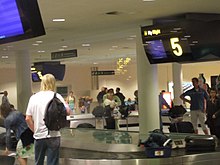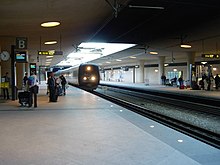Copenhagen Airport: Difference between revisions
No edit summary Tag: references removed |
m →Airlines and destinations: There are no flights Warsaw-Copenhagen by Norwegian |
||
| Line 147: | Line 147: | ||
|[[Niki (airline)|Niki]]|Vienna | 2 |
|[[Niki (airline)|Niki]]|Vienna | 2 |
||
|[[Norwegian Air Shuttle]] | Aalborg, Karup | 1 |
|[[Norwegian Air Shuttle]] | Aalborg, Karup | 1 |
||
|Norwegian Air Shuttle | Alicante, Amsterdam, Athens [begins 28 June], Barcelona, Bergen, Budapest, Dubai, Dublin, Dubrovnik, Edinburgh, Faro, Heraklion, Ibiza, Kos, Krakow, Larnaca, London-Gatwick, Malaga, Malta, Marrakech [begins 3 november], Nice, Olbia, Oslo-Gardermoen, Palma de Mallorca, Paris-Orly, Pisa, Prague, Rhodos, Rome-Fiumicino, Salzburg, Split, Stockholm-Arlanda, Vienna |
|Norwegian Air Shuttle | Alicante, Amsterdam, Athens [begins 28 June], Barcelona, Bergen, Budapest, Dubai, Dublin, Dubrovnik, Edinburgh, Faro, Heraklion, Ibiza, Kos, Krakow, Larnaca, London-Gatwick, Malaga, Malta, Marrakech [begins 3 november], Nice, Olbia, Oslo-Gardermoen, Palma de Mallorca, Paris-Orly, Pisa, Prague, Rhodos, Rome-Fiumicino, Salzburg, Split, Stockholm-Arlanda, Vienna, Zagreb | 2 |
||
|[[Novair]] | | 2 |
|[[Novair]] | | 2 |
||
|[[Ostfriesische Lufttransport]] | Bremen | 2 |
|[[Ostfriesische Lufttransport]] | Bremen | 2 |
||
Revision as of 09:52, 25 June 2010
Copenhagen Airport Københavns Lufthavn | |||||||||||||||||||
|---|---|---|---|---|---|---|---|---|---|---|---|---|---|---|---|---|---|---|---|
 | |||||||||||||||||||
| Summary | |||||||||||||||||||
| Airport type | Public | ||||||||||||||||||
| Owner | Københavns Lufthavne | ||||||||||||||||||
| Serves | Copenhagen, | ||||||||||||||||||
| Location | Kastrup | ||||||||||||||||||
| Hub for | |||||||||||||||||||
| Elevation AMSL | 5 m / 16 ft | ||||||||||||||||||
| Coordinates | 55°37′43″N 12°38′49″E / 55.62861°N 12.64694°E | ||||||||||||||||||
| Website | http://www.cph.dk | ||||||||||||||||||
| Runways | |||||||||||||||||||
| |||||||||||||||||||
| Statistics (2009) | |||||||||||||||||||
| |||||||||||||||||||
Copenhagen Airport (Danish: Københavns Lufthavn, Kastrup) (IATA: CPH, ICAO: EKCH) is the main international airport serving Copenhagen, Denmark and the Oresund Region. It is located on the island of Amager, only 8 kilometers south of Copenhagen city centre, and 24 kilometers west of Malmö city centre on the other side of the Oresund Bridge. The airport lies mainly in the municipality of Tårnby, with a small portion in neighboring Dragør. It is the largest airport in the Nordic countries, and one of the oldest international airports in Europe.
The airport is the main hub out of three used by Scandinavian Airlines and is also a hub for Cimber Sterling, Thomas Cook Airlines Scandinavia, Norwegian Air Shuttle and for transavia.com. Copenhagen Airport serves nearly 60,000 passengers per day; 19.7 million passengers passed through the facility in 2009, making it the busiest airport in the Nordic countries, with a maximum capacity of 83 loadings/hour and with room for 108 airplanes. It is owned by Københavns Lufthavne, which also operates Roskilde Airport. The airport employs 1700 staff (excluding shops, restaurants etc.).[1]
Copenhagen Airport was originally called Kastrup Airport, since it is located in the small town of Kastrup, now a part of the Tårnby municipality. The formal name of the airport is still Copenhagen Airport, Kastrup, to distinguish it from Roskilde Airport, which formally is called Copenhagen Airport, Roskilde. Locally it's still known as just Kastrup among people.
History
- 1925: CPH opens for service on 20 April. One of the first private airports in the world, it opens with a grass runway.
- 1932: 6000 take-offs and landings in the year.
- 1936–1939: New terminal, considered one of the finest examples of Nordic functionalism, is built (Architect: Vilhelm Lauritzen).
- 1941: First hard-surface runway is built.
- 1946: SAS is founded, an important event for Copenhagen Airport, as Copenhagen was to be the main hub for the airline. Traffic increases rapidly in the first years SAS operates. Also, Copenhagen Airport becomes Europe's third-largest.
- 1947: On 26 January, a KLM DC-3 crashes at the airport after stopping en route to Stockholm. 22 people die, including the Swedish prince Gustav Adolf, and the American opera singer Grace Moore.
- 1948: 150 take-offs and landings per day, and 3000 passengers are handled per day.
- 1950: 378,000 passengers are handled.
- 1954: 11,000 tonnes of freight handled per year. SAS begins the world's first trans-polar route, flying initially to Los Angeles. The route proves to be a publicity coup, and for some years Copenhagen becomes a popular transit point for Hollywood stars and producers flying to Europe.
- 1956: 1 million passengers handled per year. CPH wins the award for the world's best airport.
- 1960s: With the advent of jet airliners, debate begins about a major expansion of the airport. Jets need longer runways than had previously been used, and plans are drawn up to expand the airport either into existing communities in Kastrup or onto Saltholm, a small island. Local protests ensue and expansion is stalled for some time.
- 1960: On 30 April, Terminal 2, also designed by Lauritzen, opens. Also, a new control tower opens and the airport handles 2 million passengers per year.
- 1970s: The airport suffers from acute space shortages, especially with the advent of large jets such as 747s. After initially deciding to expand to Saltholm, the project is eventually blocked by Denmark's parliament.
- 1973: 8 million passengers handled per year. The third (long) runway opens and the dual runway system (04L/22R-04R/22L) opens, strongly expanding the capacity of possible numbers of starts and landings.
- 1982: The Cargo terminal opens.
- 1986: A parking garage with 2400 spaces opens.
- 1991: The airport is partially privatised.
- 1998: Terminal 3 opens, and the airport handles 17 million (international) passengers per year.
- 1999: Baggage handling system is modernised, and the Vilhelm Lauritzen terminal is moved 3.8 km down the runway to make room for new terminals, a hotel, and a train station for regional trains opens..
- 2000: The airport handles 18.4 million passengers per year. The train system becomes international, linking the airport also to southern Sweden.
- 2001: A five-star Hilton hotel with 382 beds opens at the airport. 267,000 take-offs and landings.
- 2005: Macquaire Airport buys 52% of stocks
- 2006: Number of passengers exceeds 20 million for the first time (20.9 million).
- 2007: A metro station opens, connecting the airport to the Copenhagen Metro.
- 2008: A new control tower is opened by Naviair as part of a major renovation of the ATC system. Airport officials announce plan to build a new low-cost terminal at the facility, which is expected to be completed by 2010.
- 2009 Macquaire Airport is spun off as MAp Airports
Airlines and destinations
Copenhagen Airport has three terminals and a new one is set to open in 2010. The new terminal, CPH Swift (see below for more information), is intended to be used by low-cost airlines.
Terminal 1 is used for all domestic flights. Terminals 2 and 3 handle international flights (both Schengen and non-Schengen) and share a common airside passenger concourse as well as the arrivals section - which houses customs and baggage claim and is physically located in Terminal 3.




| Airlines | Destinations | Terminal |
|---|---|---|
| Adria Airways | Ljubljana | 2 |
| Aeroflot | Moscow-Sheremetyevo | 2 |
| AirBaltic | Riga, Vilnius | 2 |
| Air Berlin | Berlin-Tegel, Düsseldorf, Palma de Mallorca | 2 |
| Air Canada | Toronto-Pearson | 3 |
| Air France | Paris-Charles de Gaulle | 2 |
| Air France operated by Brit Air | Lyon, Strasbourg | 2 |
| Air Greenland | Kangerlussuaq, Narsarsuaq | 2 |
| Arkia | Tel Aviv [seasonal] | 2 |
| Atlantic Airways | Vágar | 2 |
| Austrian Airlines | Vienna | 3 |
| Austrian operated by Tyrolean Airways | Vienna | 3 |
| B&H Airlines | Sarajevo | 2 |
| Blue1 | Helsinki | 3 |
| bmi operated by bmi Regional | Edinburgh, Glasgow-International | 3 |
| British Airways | London-Heathrow | 2 |
| Brussels Airlines | Brussels | 2 |
| Bulgarian Air Charter | Burgas [seasonal], Varna [seasonal] | 2 |
| Cimber Sterling | Aalborg, Århus, Billund, Bornholm, Karup, Sønderborg | 1 |
| Cimber Sterling | Alicante, Antalya, Athens, Barcelona, Bastia [begins 6 July], Belgrade, Bordeaux [begins 5 July], Burgas, Catania, Chania, Edinburgh, Florence, Larnaca, Lisbon, London-City, Madrid, Malaga, Montpellier, Naples, Newcastle upon Tyne, Nice, Norrköping, Palma de Mallorca, Rome-Fiumicino, Sofia, Split, Thessaloniki [begins 22 June], Venice-Marco Polo | 2 |
| Continental Airlines | Newark | 2 |
| Croatia Airlines | Zagreb | 2 |
| Czech Airlines | Prague | 2 |
| Delta Air Lines | Atlanta, New York-JFK | 2 |
| EasyJet | Berlin-Schönefeld, London-Gatwick, London-Stansted, Manchester, Milan-Malpensa, Paris-Charles de Gaulle [begins 10 September] | 2 |
| EasyJet Switzerland | Basle [begins 1 November], Geneva | 2 |
| EgyptAir | Cairo [begins 1 October] | 3 |
| Estonian Air | Tallinn | 3 |
| Finnair | Helsinki | 2 |
| Germanwings | Cologne/Bonn | 2 |
| Iberia Airlines | Madrid, Malaga | 2 |
| Iceland Express | Akureyri, Reykjavik-Keflavík | 2 |
| Icelandair | Reykjavik-Keflavík | 3 |
| Iran Air | Tehran-Imam Khomeini | 2 |
| Jat Airways | Belgrade | 2 |
| Jettime | Dalaman, Malta | 2 |
| Karthago Airlines | Tunis | 2 |
| KLM | Amsterdam | 2 |
| LOT Polish Airlines | Warsaw | 2 |
| Lufthansa | Frankfurt, Munich | 3 |
| Malév Hungarian Airlines | Budapest | 2 |
| Middle East Airlines | Beirut [seasonal] | 2 |
| Montenegro Airlines | Podgorica, Tivat [seasonal] | 2 |
| NextJet | Linkoping, Örebro | 2 |
| Niki | Vienna | 2 |
| Norwegian Air Shuttle | Aalborg, Karup | 1 |
| Norwegian Air Shuttle | Alicante, Amsterdam, Athens [begins 28 June], Barcelona, Bergen, Budapest, Dubai, Dublin, Dubrovnik, Edinburgh, Faro, Heraklion, Ibiza, Kos, Krakow, Larnaca, London-Gatwick, Malaga, Malta, Marrakech [begins 3 november], Nice, Olbia, Oslo-Gardermoen, Palma de Mallorca, Paris-Orly, Pisa, Prague, Rhodos, Rome-Fiumicino, Salzburg, Split, Stockholm-Arlanda, Vienna, Zagreb | 2 |
| Novair | 2 | |
| Ostfriesische Lufttransport | Bremen | 2 |
| Pakistan International Airlines | Islamabad, Lahore | 2 |
| Pegasus Airlines | Istanbul-Sabiha Gökcen | 2 |
| Qatar Airways | Doha [2] | 2 |
| Rossiya | St Petersburg | 2 |
| SATA International | Madeira | 2 |
| Scandinavian Airlines | Aalborg, Århus | 1 |
| Scandinavian Airlines | Amsterdam, Athens, Bangkok-Suvarnabhumi, Barcelona, Beijing-Capital, Bergen, Berlin-Tegel, Birmingham, Bologna, Brussels, Bucharest-Henri Coanda, Chicago-O'Hare, Dubai [seasonal], Dublin, Düsseldorf, Frankfurt, Gdansk, Geneva, Gothenburg-Landvetter, Helsinki, Kiev-Boryspil, Kristiansand, London-Heathrow, Lyon, Madrid, Malaga [seasonal], Manchester, Milan-Linate, Milan-Malpensa, Moscow-Sheremetyevo, Munich, Newark, Nice, Oslo-Gardermoen, Paris-Charles de Gaulle, Pristina [seasonal], Rome-Fiumicino, St Petersburg, Stavanger, Stockholm-Arlanda, Stuttgart, Tokyo-Narita, Turku, Venice-Marco Polo, Vilnius, Warsaw, Washington-Dulles, Zürich | 3 |
| Scandinavian Airlines operated by Cimber Sterling | Aalesund, Aberdeen, Bergen, Berlin-Tegel, Bucharest-Henri Coanda, Gdansk, Geneva, Gothenburg-Landvetter, Hamburg, Hanover, Helsinki, Kristiansand, Luxembourg, Palanga, Poznan, Stavanger, Stuttgart, Turku, Warsaw | 3 |
| Singapore Airlines | Singapore | 3 |
| Sky Airlines | Antalya | 2 |
| Skyways Express | Karlstad, Jonkoping | 3 |
| Spanair | Barcelona, Madrid, Malaga, Palma de Mallorca | 3 |
| Swiss International Air Lines | Zürich | 2 |
| Syrian Air | Damascus | 2 |
| TAP Portugal | Lisbon | 2 |
| Thai Airways International | Bangkok-Suvarnabhumi | 3 |
| Transavia.com Denmark | Alghero, Barcelona, Chania, Faro, Innsbruck, Las Palmas de Gran Canaria, Malaga, Montpellier, Naples, Nice, Palma de Mallorca, Pisa, Rome-Fiumicino, Salzburg, Tenerife-South | 2 |
| Turkish Airlines | Istanbul-Atatürk | 2 |
| Turkish Airlines operated by AnadoluJet | Ankara, Istanbul-Sabiha Gökcen | 2 |
| Widerøe | Sandefjord, Trondheim | 3 |
| Wind Jet | Forlì | 2 |
Cargo airlines
| Airlines | Destinations |
|---|---|
| DHL Aviation | East Midlands, Leipzig/Halle |
| DHL Aviation operated by Exin | Stavanger |
| FedEx Express | Helsinki, Stockholm, Paris-Charles de Gaulle |
| Korean Air Cargo | Seoul-Incheon |
| Singapore Airlines Cargo | Singapore |
| China Cargo Airlines | Shanghai-Pudong |
| Air China Cargo | Beijing-Capital, Paris-Charles de Gaulle, Shanghai-Pudong |
Ground transport

The airport can be accessed in various ways:
- Rail - the airport's station is located underneath Terminal 3 on the Øresund Railway Line and is served by Øresundstogene, the main way to get into the city centre, and to Helsingør, to Malmö, and other Swedish cities. Danish intercity trains terminate at this station, going to places in Denmark such as Esbjerg, Århus, Frederikshavn and Padborg, where connections are available for trains to Germany. Also, SJ operates X2000 high-speed trains to Stockholm and to Gothenburg.
- Metro - Line M2 of the Copenhagen Metro links the airport with the city centre.
- Bus - Movia buses 5A, 35, 36 and 96 N and Gråhundbus line 999 all stop at the airport; bus 888, express-bus to Jutland, also stops at the airport. Movia bus 2A stops near the airport. There are long-distance buses to Sweden.
- Motorway - the E20 runs right by the airport. The E20 uses the Oresund Bridge to Sweden. The airport has 8,600 parking spaces. Customers can pre-book their parking space online by visiting the Copenhagen Airport website [1].
Incidents and accidents

- On 26 January 1947, Douglas Dakota, PH-TCR of KLM crashed after takeoff from Copenhagen, killing all 22 onboard, including Prince Gustaf Adolf of Sweden. The delayed KLM flight from Amsterdam had landed at Copenhagen for a routine stop before continuing to Stockholm. Soon after the Douglas DC-3 aircraft took off, it climbed to an altitude of about 50 metres (150 feet), stalled, and plummeted nose-first to the ground where it exploded on impact. Also aboard the ill-fated flight was American singer and actress Grace Moore. The investigation showed that the crash had been caused by a forgotten rudder lock. Short of time, the captain never performed his checklist and took off not realizing the lock was still in place.
- On 17 November 1957, Vickers Viscount G-AOHP of British European Airways crashed at Ballerup after the failure of three engines on approach to Copenhagen Airport. The cause was a malfunction of the anti-icing system on the aircraft.[3]
- On 28 August 1971, a MALÉV Ilyushin Il-18, HA-MOC crashed into the sea while executing an instrument approach. The main cause of the accident was microburst, a particularly dangerous and unpredictable meteorological phenomenon. 23 passengers and the crew of 9 died. 2 passengers survived. The captain of the plane was WWII flying ace of the Royal Hungarian Air Force, Dezső Szentgyörgyi. He was due to retire in less than 3 weeks.
See also
References
![]() This article incorporates public domain material from the Air Force Historical Research Agency
This article incorporates public domain material from the Air Force Historical Research Agency
- AIP Denmark: Koebenhavn/Kastrup - EKCH
- VFR Flight Guide Denmark: Koebenhavn/Kastrup - EKCH
- ^ Copenhagen Airports - Copenhagen Airports
- ^ http://www.cph.dk/CPH/DK/MAIN/Flytider/Nye+ruter+og+frekvenser/2010.htm
- ^ "Accident description". Aviation Safety Network. Retrieved 8 September 2009.
